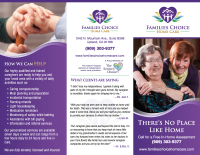
Caregivers help their clients age safely and comfortably in their homes while prioritizing social engagement and an active daily routine. However, safety is always a top priority.
Southern California and the Inland Empire are vulnerable to fire and flash flood threats, not to mention earthquakes and long-term power outages. Developing, practicing, and maintaining an emergency plan is essential to ensure your parents or grandparents are cared for in a worst-case scenario.
Whether your aging loved one lives alone or you’re in the process of finding professional in-home caregivers, preparing for emergencies is essential.
How to Prepare for Emergencies With Elderly Loved Ones
If you already enlist the support of a caregiver, go over this checklist with them and ensure they implement it. Otherwise, you can help your loved one prepare for an emergency by doing the following.
1. Prioritize safe and accessible floor plans
We can’t believe how many articles about emergency preparedness for elderly clients and caregivers neglect to mention safe accessibility. In an emergency, you and your loved one must be able to implement the safety plan quickly—and without trip/fall hazards.
Creating a safe and accessible home space and honoring key fall-prevention strategies prevents aging loved ones or their caregivers from injuring themselves while implementing the emergency evacuation plan!
2. Create an emergency preparedness team (family, neighbors, friends, etc.)
The first step is to create an emergency preparedness team for your loved one. This requires contacting the people most willing to help in an emergency. Typically, an emergency support team includes trusted:
- Neighbors
- Family or friends who live nearby
- A religious or spiritual group that keeps lists of members who need them
These individuals must agree to their role and practice the drills or plans to ensure everything works. They should all have:
- Clear instructions about various emergencies (fire, flood, power outages, medical, etc.)
- Copies of the house and car keys to gain entrance (or know where these are hidden)
- Contact information for all of the other members
- Vital medical information including medication instructions, primary healthcare providers, instructions for portable oxygen supply, and so on)
Finally, someone out of town should be designated as the team’s chair or “captain” because a local emergency could render locals less able to jump in and help.
3. A medical emergency kit
A medical emergency kit is similar to a first-aid kit but also includes extras that would be necessary in a longer-term event. We recommend using a clear, plastic storage tote that is stored in an easy-to-access and well-marked cupboard or closet.
Any items you’d take with you should be packed into a roller suitcase or duffel for easy transport.
The travel portion of the kit should include things like:
- Medications and instructions for at least two weeks
- Two changes of clothes
- A pack of adult underwear
- Complete toiletry kit
- Bottled water (at least a two-day supply)
- Portable oxygen tank (if needed)
- Non-perishable snacks including canned meats, applesauce, jerky, snack bars, etc.
- Food and containers for pets
- A blanket and a small pillow
- A picture, photo, or other familiar item that would bring comfort
- Flashlight and extra batteries
- Multipurpose tool (that includes a can opener)
Visit the Red Cross’s post, What Do You Need in a Survival Kit, for more ideas.
4. Emergency-specific instructions
Again, that clear plastic tote should include everything the support network needs in case of an emergency. This should consist of separate sets of instructions for different types of emergencies:
- Fire
- Earthquake
- Flood
- Long-term power outage
- Unplanned natural disasters
- Medical emergencies
By creating detailed instructions for specific emergency scenarios, caregivers can follow the “playbook” rather than having to recreate the wheel or execute a new plan while in the middle of an emergency.
These instructions should include information about:
- Main water line shut-off location
- Main circuit breaker location
- Any tools required to turn main valves on/off
- Various safe emergency exits
- Any other potential hazards or safety information relevant to the home or apartment
5. Create a map (and instructions) for the evacuation route
Your loved one’s community has its own instructions for emergencies and natural disasters. Emergency preparedness for the elderly means familiarizing yourself with these plans—including evacuation routes.
Things to know include:
- Safest evacuation route out of the home or building, taking into account any mobility issues
- Safest routes to evacuate the neighborhood and larger community
- Places to go if extended power outages put your loved one at risk for oxygen deprivation, excessive heat/cold, or lack of water (many well systems rely on electricity to pump water into the holding tank)
- Routes to area shelters
- Transportation options in an emergency
All of this information should be available in the emergency kit and well-understood by your loved one’s personal team of “emergency responders.”
6. Practice the plan
The emergency plans should be practiced at least once a year (twice a year is even better) to keep the responders aligned and up to speed. In addition to helping create muscle memory, practicing how to prepare for emergencies with elderly loved ones – and related drills – provides the opportunity to notice and correct any outdated information or contacts.
It also gives team members the chance to bow out if necessary. Previously willing neighbors or family members may have moved, experienced their own health issues, or just may not be as suited to the task anymore. Practicing the plan ensures it remains relevant year after year.
Families Choice Home Care Creates and Maintains Client Emergency Plans
Families Choice Home Care takes client safety and emergency preparedness seriously. We continuously review our client’s safety plans and implement practice sessions to ensure our care teams know precisely what to do, and whom to contact, in an emergency.
If your loved ones haven’t established an emergency preparedness plan yet, we’ll begin creating one with participating family members, friends, and neighbors. Just click below to get started.





